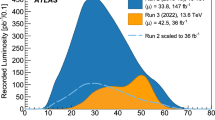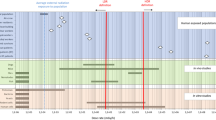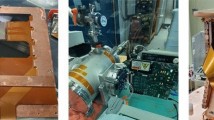Abstract
A new method to determine the spectra of linear energy transfer (LET) based on track-etch detectors has been developed. It is based on chemically etched polyallyldiglycolcarbonate (PADC) track detector. LET spectra are calculated using the track parameters measured with an automatic optical image analyzer. This method has been recently improved; the calibration curves have been upgraded on the basis of evaluating the detectors exposed in heavier high-energy charged particle beams. The LET spectrometer has been used to determine LET spectra and integral dosimetry characteristics along the range of protons, resp. 12C ions with primary energies of 205 MeV, resp. about 480 MeV/amu; and to study the importance of the fragmentation and nuclear reactions in carbon and other heavier ion beams. The results obtained are analyzed and discussed; the possible advantages of this type of equipment are outlined.
Similar content being viewed by others
References
J. Charvát, “LET Spectrometry with Polymer SSNTD’s,” PhD Thesis (Czech Techn. Univ., Prague, 1985).
F. Spurný et al., “LET Spectra of Secondary Particles in CR 39 Track Etch Detector,” Rad. Meas. 26, 645–649 (1996).
P. Pihet et al., “A Biological Weighting Function for RBE Specification of Neutron Therapy Beams. Intercomparison of 9 European Centres,” Rad. Prot. Dos. 31, 437–442 (1990).
T. Loncol et al., “Radiobiological Effectiveness of Radiation Beams with Broad LET Spectra: Microdosimetric Analysis Using Biological Weighting Functions,” Rad. Prot. Dos. 52, 347–352 (1994).
A. Wambersie and H. G. Menzel, “Dose Specification in Heavy Particle Therapy (A Review),” Rad. Prot. Dos. 70, 517–527 (1997).
Results from the First Two Intercomparison of Dosimetric Instruments for Cosmic Radiation with Heavy Ions Beams at NIRS (ICCHIBAN-1 & 2) Experiments, Ed. by Y. Uchihori and E. R. Benton, HIMAC-078, NIRS (Chiba, Japan, 2004).
F. Spurný, A. G. Molokanov, and V. P. Bamblevski, “Passive Spectrometry of Linear Energy Transfer: Developments and Use,” Rad. Prot. Dos. 110, 675–679 (2004).
F. Spurný et al., “Upgrading of LET Track-Etch Spectrometer Calibration,” Rad. Meas. 40, 343–346 (2005).
F. Spurný et al., “Determination of Dosimetric Characteristics in Radiotherapy Proton Beams,” JINR Preprint P16-89-353 (Dubna, 1989).
A. G. Molokanov and F. Spurný, “Biologically Weighted Effective Dose in 205 MeV Clinical Proton Beam,” Phys. Med. Biol. 50, 281–287 (2005).
“Clinical Proton Dosimetry. Part I: Beam Production, Beam Delivery and Measurement of Absorbed Dose,” ICRU Report 59 (Bethesda, 1998).
“Stopping Powers and Ranges for Protons and Alpha Particles,” ICRU Report 49 (Bethesda, 1993).
H. Paganetti, “Nuclear Interactions in Proton Therapy: Dose and Relative Biological Effect Distributions Originating from Primary and Secondary Particles,” Phys. Med. Biol. 47, 747–764 (2002).
J. V. Tang et al., “Comparison of Radiobiological Effective Depth in 65 MeV Modulated Proton Beams,” Br. J. Cancer 76, 220–225 (1997).
A. Vitanova et al., “Study of the Clinical Beam Relative Biological Effectiveness at the JINR Phasotron, Dubna,” JINR Commun. P16-2002-71 (Dubna, 2002).
A. G. Molokanov and F. Spurný, “Measurements of the 12C Ion Beam Microdosimetric Characteristics,” JINR Commun. P16-2005-86 (Dubna, 2005).
J. F. Ziegler, J. P. Biersack, and U. Littmark, The Stopping and Range of Ions in Matter (Pergamon Press, 1985); www.SRIM.org.
F. Spurný et al., “ICCHIBAN 8 Experiment: Results of NPI AS CR Participants with TLDs and Different rach Etched Detectors (TED),” Results Available at the End of July 2006, Report DRD NPI AS CR 573/06 (Prague, 2006).
I. Jadrníçková, “Spectrometry of Linear Energy Transfer and Its Use in Radiotherapy and Radiation Protection in High-Energy Particle Fields,” PhD Thesis (Czech Techn. Univ., Prague, 2006).
H. Iwase, K. Niita, and T. Nakamura, “Development of a General-Purpose Particle and Heavy Ion Transport Monte Carlo Code,” J. Nucl. Sci. Technol. 39, 1142–1151 (2002).
C. La Tessa et al., “Fragmentation of 1 GeV/Nucleon Iron Ions in Thick Targets Relevant for Space Exploration,” Adv. Space Res. 35, 223–229 (2005).
M. Soukup, “Accurate Methods of Dose Computation in Proton Therapy,” PhD Thesis (Czech Techn. Univ., Prague, 2006).
I. Gudowska et al., “Ion Beam Transport in Tissue-Like Media Using the Monte Carlo Code SHIELD-HIT,” Phys. Med. Biol. 49, 1933–1958 (2004).
Author information
Authors and Affiliations
Additional information
The text was submitted by the authors in English.
Rights and permissions
About this article
Cite this article
Jadrníčková, I., Spurný, F. & Molokanov, A.G. Spectrometry of linear energy transfer and its use in high-energy particle beams. Phys. Part. Nuclei Lett. 5, 531–537 (2008). https://doi.org/10.1134/S1547477108060071
Received:
Published:
Issue Date:
DOI: https://doi.org/10.1134/S1547477108060071




